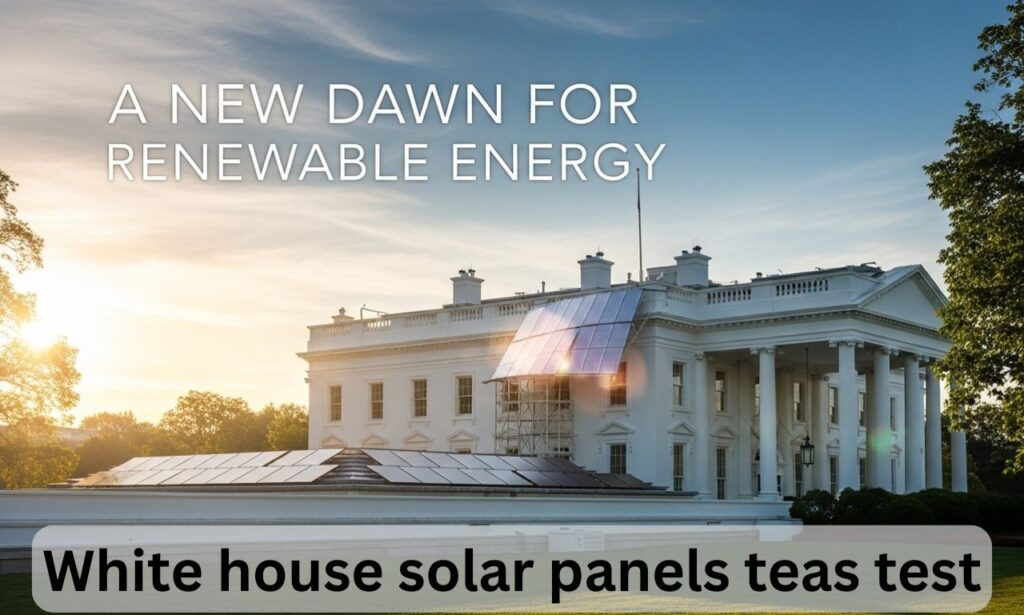As the sun rises over the iconic White House, it brings with it a glimmer of hope for a greener future. The recent implementation of the White House solar panels teas test marks a significant step towards embracing renewable energy in one of the world’s most recognized buildings. This initiative not only showcases leadership in sustainability but also sets an example for cities and nations around the globe. With climate change pressing on our heels, how does this ambitious project unfold? Let’s dive into what makes this test so vital to our energy landscape and explore its potential impact on renewable resources across America.
What is White house solar panels teas test?
The White House Solar Panels Teas Test is a groundbreaking initiative aimed at evaluating the efficiency and effectiveness of solar panels installed on government properties. This test serves as a litmus for how renewable energy can be harnessed in high-profile locations.
By analyzing different types of solar technology, the test provides valuable insights into performance metrics such as energy output and sustainability. It showcases the federal commitment to adopting cleaner energy solutions.
Conducted over varying weather conditions, this innovative assessment helps identify how well these systems operate throughout different seasons. Data collected during this testing phase will guide future policies related to renewable energy adoption across the nation.
It reflects an evolving perspective on environmental responsibility within one of America’s most iconic buildings. The implications extend beyond just aesthetics; they signal a shift toward greener practices in governance and public policy.
How the Test Works and Its Impact on Renewable Energy
The White House solar panels teas test is an innovative method designed to assess the efficiency of solar energy systems. It combines rigorous performance evaluations with public engagement. This groundbreaking approach allows for real-time analysis of how well solar panels can convert sunlight into usable energy.
Participants in the test include various stakeholders, from government officials to environmental advocates. Their insights help refine strategies for optimal panel installation and usage.
The implications are significant. By showcasing effective solar solutions, this initiative promotes wider adoption across communities. As more buildings utilize solar technology, it fosters a culture of sustainability that resonates throughout the nation.
Moreover, increased visibility around such tests encourages investment in renewable technologies. It sends a clear message: embracing clean energy is not just an option; it’s becoming essential for our future prosperity and ecological health.
The Benefits of Using Solar Energy
Solar energy offers a multitude of benefits that extend beyond mere environmental impacts. First and foremost, it significantly reduces electricity bills for homeowners and businesses alike. By harnessing the sun’s power, users can generate their own electricity, leading to substantial savings over time.
Another key advantage is the reduction of greenhouse gas emissions. Solar panels produce clean energy without releasing harmful pollutants into the atmosphere. This shift plays a vital role in combating climate change and promoting healthier air quality.
Moreover, solar installations create jobs within local communities. From manufacturing to installation and maintenance, this green technology stimulates economic growth while fostering a sustainable future.
Solar energy provides energy independence. By relying on domestic resources instead of imported fossil fuels, countries can enhance their resilience against global market fluctuations and geopolitical tensions related to energy supplies.
Challenges and Controversies Surrounding Solar Energy
Solar energy, despite its many advantages, faces several challenges. One of the most pressing issues is the initial cost. High installation expenses can deter homeowners and businesses from making the switch.
Another significant concern revolves around land use. Large solar farms require substantial space, often leading to conflicts over agricultural land or natural habitats. This raises questions about environmental trade-offs.
Moreover, there’s a debate on efficiency and reliability. Solar panels depend heavily on sunlight availability. In regions with less sun exposure or during winter months, energy production can dip significantly.
Additionally, some critics highlight concerns regarding waste management associated with solar panel disposal at the end of their lifecycle. It poses a dilemma for sustainability advocates who champion renewable sources as entirely eco-friendly.
Policy changes can create uncertainty in this growing market. Fluctuating incentives affect both investment decisions and consumer adoption rates across various states.
Success Stories of Other Countries Using Solar Energy
Countries around the globe are embracing solar energy, showcasing remarkable success stories. Germany stands out with its ambitious transition to renewable sources, boasting over 2 million solar installations. Their commitment has made them a leader in reducing carbon emissions.
In China, massive investments have spurred rapid advancements in solar technology. The nation is now the largest producer of solar panels and has significantly increased its clean energy output, helping combat air pollution while powering millions of homes.
Meanwhile, India is harnessing sunlight through innovative initiatives like the Solar Parks scheme. This program aims to generate large-scale electricity from solar farms across vast desert regions.
Even smaller nations like Costa Rica rely heavily on renewable energy sources, with an impressive percentage of their electricity coming from hydropower and increasingly from solar innovations. These examples illustrate how diverse strategies can propel countries toward sustainable futures powered by the sun’s rays.
The Future of Renewable Energy in the United States
The future of renewable energy in the United States looks promising. As technology advances, solar, wind, and other forms of sustainable energy are becoming more efficient and accessible.
In urban areas, rooftop solar installations are rapidly gaining popularity. Homeowners see the value in reducing their electricity bills while contributing to a cleaner environment.
Government incentives also play a significant role in this shift. Tax credits and grants encourage individuals and businesses to invest in green technologies.
Moreover, corporations increasingly prioritize sustainability initiatives. This trend reflects consumer demand for eco-friendly products and practices.
Innovative storage solutions are emerging as well. Battery technology development enables better energy capture for use during peak times or inclement weather.
As collaboration between public sectors and private companies strengthens, we can expect an accelerated transition towards a greener economy that prioritizes renewable resources over fossil fuels.
The Importance of Investing in Renewable Energy for a Sustainable Future
Investing in renewable energy is crucial for a sustainable future. As climate change intensifies, reliance on fossil fuels becomes increasingly untenable. Transitioning to cleaner sources of power can help mitigate environmental degradation.
Renewable energy technologies like solar and wind create jobs, boost local economies, and reduce dependence on imported fuels. This shift promotes energy independence, making nations more resilient against global market fluctuations.
Moreover, harnessing renewable resources helps preserve natural ecosystems. Clean energy initiatives often lead to reduced air and water pollution, benefiting public health significantly.
Long-term investments in renewables also pave the way for innovation. Advancements in battery storage and smart grid technology enhance efficiency while lowering costs over time.
Embracing renewable energy shapes a more equitable world by ensuring access to clean power for all communities—an essential step towards addressing social inequalities tied to traditional energy sources.
Final Thought
As the White House solar panels teas test unfolds, it signifies a pivotal moment for renewable energy in the United States. This initiative not only showcases the effectiveness of solar technology but also serves as an inspiration for other nations looking to pivot towards sustainable practices.
The adoption of solar energy is more than just a trend; it’s a necessary step towards combating climate change and reducing our carbon footprint. The success stories from countries that have embraced this shift highlight its viability and potential. As we look to the future, investing in renewable resources like solar power will play a crucial role in ensuring a sustainable environment for generations to come.
Embracing clean energy sources is no longer an option—it’s essential. The world watches closely as this experiment at the heart of American politics could set new benchmarks for global sustainability efforts. With continued support and investment, the possibilities are limitless, making way for a brighter, greener tomorrow.






